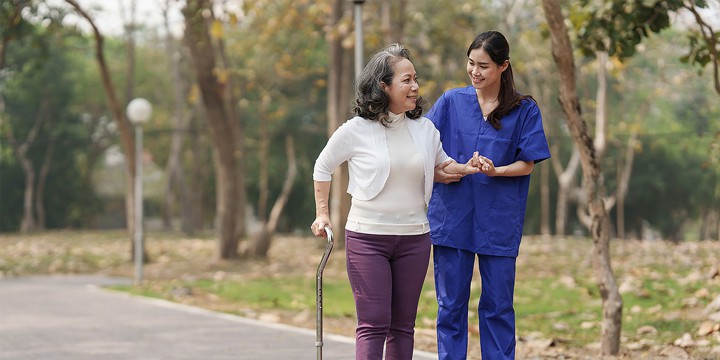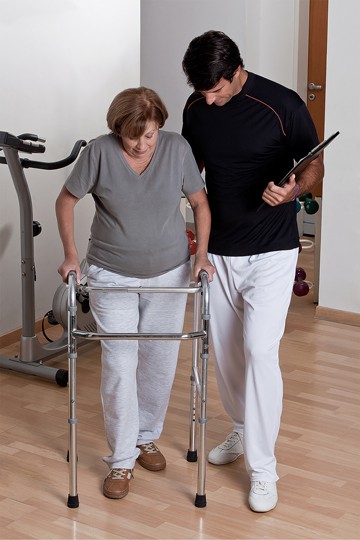 A stroke can dramatically change a senior’s life, leaving potential physical, cognitive, and emotional challenges to cope with. Recovery from a stroke can be a long and arduous process, especially for older adults. However, assisted living communities can provide essential rehabilitation services and support tailored to seniors, helping them regain their independence and improve their quality of life. This article discusses the challenges seniors may face during stroke recovery and how assisted living communities can offer comprehensive rehabilitation services to address these challenges.
A stroke can dramatically change a senior’s life, leaving potential physical, cognitive, and emotional challenges to cope with. Recovery from a stroke can be a long and arduous process, especially for older adults. However, assisted living communities can provide essential rehabilitation services and support tailored to seniors, helping them regain their independence and improve their quality of life. This article discusses the challenges seniors may face during stroke recovery and how assisted living communities can offer comprehensive rehabilitation services to address these challenges.
Understanding the Challenges of Stroke Recovery for Seniors
A stroke occurs when blood flow to part of the brain is either blocked by a clot (ischemic stroke) or a blood vessel bursts (hemorrhagic stroke), which can result in brain cells being deprived of oxygen and nutrients, leading to cell death. In seniors, the recovery process can be particularly challenging due to age-related factors such as reduced physical strength, reduced cognitive abilities, and the presence of other health conditions.
Common challenges seniors face after a stroke include:
- Physical limitations: muscle weakness, balance problems, and reduced mobility
- Cognitive issues: memory loss, difficulty concentrating, and communication challenges
- Emotional and psychological challenges: depression, anxiety, and emotional instability
- Increased dependency: need for support and assistance in daily activities
By addressing these challenges, seniors can start building tangible skills and confidence in their capabilities. And an improvement in quality of life can help reduce the risk of further health complications.
Physical Rehabilitation Services in Assisted Living Communities

One of the primary goals of rehabilitation after a stroke is to address physical limitations and help seniors regain their functional mobility and independence. Assisted living communities can provide seniors with various physical rehabilitation services designed to target specific stroke-related issues. These services can include:
-
Physiotherapy:
Trained physios target muscle weakness, balance issues, and mobility limitations by developing individualized exercise programs. These programs can include exercises to improve strength, flexibility, and endurance.
-
Occupational Therapy:
Occupational therapists assist seniors in relearning daily activities, such as eating, dressing, and bathing. They also provide strategies and adaptive equipment to make these tasks easier and safer for stroke survivors.
-
Speech and Swallowing Therapy:
Speech-language pathologists work with seniors who have communication or swallowing difficulties after a stroke. They provide strategies and exercises to improve speech, language, and swallowing functions.
-
Hydrotherapy:
Some assisted living communities have on-site aquatic therapy facilities, providing a safe and comfortable environment for seniors to perform exercises and improve their strength, balance, and cardiovascular fitness.
Cognitive Rehabilitation Services in Assisted Living Communities
Cognitive deficits, like memory loss, difficulty focusing, and communication challenges, are common after a stroke. Assisted living communities can provide mental rehabilitation services tailored to seniors’ individual needs. These services can include:
-
Cognitive-Behavioral Therapy (CBT):
CBT can help seniors address negative thoughts, emotions, and behaviors that may be contributing to cognitive challenges. A trained therapist provides guidance and support to help stroke survivors develop strategies for problem-solving, decision-making, and maintaining healthy thought patterns.
-
Memory Training:
Seniors can work with specialists who provide exercises and strategies to improve memory function. Memory training may also incorporate the use of assistive devices and memory aids.
-
Communication Training:
Speech-language pathologists work with seniors to improve their communication skills, including speaking, listening, reading, and writing. They provide individualized support and strategies to help seniors overcome communication challenges.
Emotional and Psychological Rehabilitation Services in Assisted Living Communities
The emotional and psychological well-being of seniors is crucial during stroke recovery. Depressive symptoms and anxiety are common in stroke survivors and can hinder rehabilitation progress if not addressed. Assisted living communities can provide the necessary support to address emotional and psychological challenges, which may include:
-
Counseling Services:
Licensed counselors work with seniors individually or in group settings to help them cope with their emotions, process their experiences, and develop coping strategies. Counseling can be beneficial in addressing feelings of depression, anxiety, and other emotional difficulties.
-
Art Therapy:
Creative expression can be a therapeutic method for seniors healing from a stroke, allowing them to express their emotions, explore their feelings, and boost self-esteem. Art therapy can include various art forms, such as painting, drawing, sculpture, and collage.
-
Support Groups:
Stroke survivor support groups can provide a safe space for seniors to share their experiences, learn from others, and gain valuable emotional support during recovery.
FAQs Related to Assisted Living Rehabilitation Services
- Q: How do I know if an assisted living community offers stroke rehabilitation services?
- Before choosing an assisted living community, one must inquire about the specific rehabilitation services offered. Many communities provide comprehensive rehabilitation programs for seniors recovering from a stroke, but it is important to confirm this and discuss individual needs with the community staff.
- Q: Can family members be involved in the rehabilitation process at an assisted living community?
- Yes, most assisted living communities encourage family involvement in the rehabilitation process, as support from loved ones is crucial to the senior’s success in recovery. Family members may collaborate with the rehabilitation team, attend therapy sessions, and provide emotional support to their loved one throughout the journey.
- Q: How long does stroke recovery and rehabilitation typically take in an assisted living community?
- The stroke recovery timeline is different for each individual and can depend on multiple factors, including the severity of the stroke, the senior’s overall health, and their response to rehabilitation services. While some individuals may notice improvements within weeks or months, others can take longer or require ongoing support. Assisted living communities can provide continuous care and adjust rehabilitation services based on individual progress.
Assisted Living Communities Play a Role in Stroke Recovery
Addressing the challenges of stroke recovery in seniors is essential in helping them regain their independence and improve their quality of life. Assisted living communities can provide a comprehensive range of rehabilitation services tailored to each senior’s individual needs of seniors during this recovery process. By offering physical, cognitive, and emotional rehabilitation services, assisted living communities can significantly support seniors in overcoming the difficulties they may face after a stroke.

